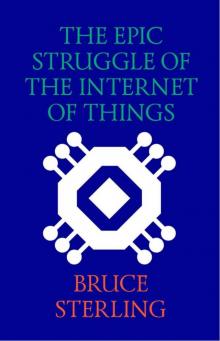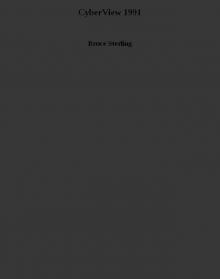- Home
- Bruce Sterling
The Epic Struggle of the Internet of Things Page 3
The Epic Struggle of the Internet of Things Read online
Page 3
That act is a “disruption”. All the Big Five ache to disrupt one another, to disrupt intensely, until their rivals vanish from the map without a trace. However, by nature all aristocrats also share a class interest; they may joust incessantly but they don’t bluntly murder each other in total war and sow the fields with salt. They have diplomatic protocols.
The Internet of Things is festooned with protocols. It is cracked and riddled with them from top to bottom. Protocol number one, of course, is the imperial namesake: the beloved Internet Protocol, TCP/IP. The internet, through a disruption, gave away for nothing what the great analogue phone companies used to sell: planetary access. The protocol of the Internet of Things is the aristocratic code of the IoT hacker-lords.
However, well before the imperial triumph of the internet, there were a lot of lesser networks, using other protocols. The Internet of Things would love to be the planet’s one-and-only form of protocol, but it’s probably not possible for reasons of physics. It’s become pretty easy for a computer to talk to a computer with Internet Protocol. And smartphones can talk to smartphones, too (although telephone companies are a proud and ancient people who hate and fear the internet and seethe with vengeful rebellion). Even your fridge can more-or-less use the Internet Protocol, because it has an electrical wire plugged straight into the wall.
However, things with the Internet Protocol always starve for electrical power. The Internet Protocol needs electrons, voltage. Most “things” don’t have any wall plugs, and batteries are expensive impositions with short lives.
It follows that most “things” are too humble and common to use the elaborate, aristocratic protocol of the Internet of Things. Lesser things have come to make do with alien protocols that use less electricity, such as MQTT, XMPP and DDS. These unruly “things” are like Balkan peasants muttering Albanian and Croat when their lords and masters want them to speak classical Latin.
It gets worse: “things” without wires of course need some “wireless” to join the network. Wireless lurks in the planet’s radio spectrum in a Byzantine variety, in arcane, difficult variants such as WiFi and Bluetooth, and UltraWideband... and also WiMax, WiBro and RFID, and Zigbee… and the telecom protocols, too – the ever-mutating 2G, 3G and 4G. Every one of these protocols is a potential schism within the IoT empire. They’ve all attracted palace cliques of alliances and consortia anxious to promote their own interests.
Plus, if you really want to get a machine to do something useful – to perform, as opposed to just sitting there “talking” to the Internet of Things – then it also needs some system of machine-to-machine commands. Digital machine-control software is fiercely complicated, not to mention potentially flammable, explosive and so on.
So the devil is in the technical details – they’re not merely technical minutiae, something that pure-hearted engineers and efficient, impartial standards boards can fix in a jiffy. No, they are the focus points for energetic wrangling, schemes the wily players can adroitly use to screw each other over.
Despite these fault lines, there’s a feeling that the IoT just has to happen. Everybody near it sensed, with a vague theological conviction, that the internet was sure to see a whole lot of “thinging” once internet connectivity hit a certain price point: five bucks. For five lousy US dollars you can attach a thing to the internet! It’s fantastic, amazing, so different, such an advance! How could that not work out?
Well, it doesn’t have to work. Back in the previous, failed Internet of Things Crusade – the doomed one with the RFID chips, as the reader may recall – the magic number was not five bucks, but five lousy cents. If you can put a chirping, electronic RFID barcode onto a thing for five cents, how can any Thing fail to be coded?
It made wondrous technical sense: it didn’t work out. It was technically sweet, but the ethical, legal, social, political implications were unmanageable. The whole scheme collapsed in an all-too-human tangle of wrangle.
However, that defeat’s been forgotten. Anyway, that was then, this is now. The new campaigners of the IoT are faster, stronger, smarter, better armed, and Wal-Mart and the Pentagon are keeping a low profile. Even the Big Five are by no means the whole story of the Internet of Things, although each desperately wishes it was.
Let’s consider the means, motives and opportunities of some of these secondary players – the lesser dukes, earls, knights, mercenary captains and ambitious adventurers. They wrangle. A lot.
Cisco should rank first among them because Cisco’s reframing of the situation has been brilliant. Its house version of the IoT is the IoE, the “Internet of Everything”. By this declaration, Cisco means all those minor, lesser “things” that the internet leaves out and overlooks.
Cisco’s version of “cloud computing” has the interesting neologism “fog computing”. Cisco’s ambitions matter because, in point of technical fact, the legacy internet was never intended to deal with “things”, and Cisco knows that well.
Real-world industrial processes need to be fast and accurate. They can’t hang around waiting for some community manager in distant Facebook headquarters to decide that they’re getting social-media traction. If a factory’s assembly has five million rapidly moving parts, it’s a fool’s errand to offshore its management to an Amazon Cloud in distant Seattle. So the Cisco “fog” is local – it’s super-local.
The “fog” is an anti-cloud, it’s local on purpose. As a factory’s owner, why would you ever want the “Amazon Cloud” to know what you are doing? They have total oversight over your accumulated stacks of data; you have zero oversight over Jeff Bezos. How long will you stay in business under those conditions? Did you ever ask an independent bookstore or a publisher about that situation?
Cisco is not one of the Big Five, but Cisco offers fewer imperial difficulties than they do. Cisco sells fast connectivity machinery. Pure and simple: no surveillance added. Once you’re inside a fog, you can generally see pretty well. A snooping overlord from outside the fog sees nothing much.
Then there’s Intel, the great exiled prince of the IoT. Intel and Microsoft used to be “Wintel”, the invincible Windows-Intel duopoly. Microsoft would make stronger software, while Intel would make stronger hardware. The “consumer”, the “user”, would cheerily buy a stronger desktop machine every year or so: more RAM, more ROM. The realm flourished.
Then Microsoft bogged down in its effective desktop monopoly, while Facebook, Amazon, Google and even Apple roamed the land. They introduced the iPhone, Android, tablets, sociality, all that… mostly run with meagre little chips, more primitive than Intel’s elaborate, knightly heavy iron. Through clinging to its trusted Windows brother, Intel had lost its chance at the smartphone business.
In response, a vengeful Intel, which has plenty of money and has never lacked for smarts, has begun flooding the world with new, smaller, lighter forms of silicon, and forming new alliances with a motley gang of startups and fringe players. Intel was never a consumer company – it makes and sells electronic components. Intel used to make and sell Microsoft’s bulldozers, but now Intel is scattering unheard-of forms of disruptive silicon, right, left and centre. Intel courts academics, inventors, artists, the Maker contingent. Intel is arming the rabble.
Then there’s General Electric. This ancient, time-honoured house makes jet engines. They’re so ancient that they’re still loyal to the cause of Things, like Celts in the Norman Invasion.
General Electric once knew all there was to know about jet engines. That’s why they reacted in horror when they realised that digital intruders were in danger of knowing much more that they did. Whenever normal, conventional industrialists build a jet engine, they do a lot of math first, they smelt out the parts, and then fire it up and they see how it explodes.
The Internet of Things industrial approach is radically different. Basically, it covers a jet engine with about a zillion spy devices and x-rays it in real time, compiling a colossal Big Database of the thing’s behaviour. This scheme required a sca
rifying level of computational power that General Electric did not, at that point, possess. However, GE knew better than to give away power to the marauding likes of the Big Five.
Instead, General Electric formed its own computational elite. It hauled in a blinking and disbelieving AT&T, plus veteran IBM, wily Cisco and disgruntled, ingenious Intel. It even got the tacit approval of the US federal government: a legal and political permission that the Big Five would never bother to ask for. The “Industrial Internet” is more than a palace clique. It’s the major armed force on the IoT landscape.
Even the Big Five majors wouldn’t dare to risk the fury of this coalition; likely, some diplomatic negotiation is in order, ornate schemes involving dynastic marriages, glittering joint enterprises, much-trumpeted pilot projects, that sort of thing.
However, suppose that you are “internet”, but you don’t happen to be American. If that’s the case, then the strategic alliance of GE, AT&T, IBM, Cisco and Intel looks an awful lot like a military-industrial “Internet of American Things”. Their “Industrial Internet” might, perhaps, be perceived as a scary, NSA-friendly, neo-Cold War apparatus from the world’s last remaining military superpower. An electronic cyberwar conspiracy, aimed directly at the future prosperity of Huawei – or even harmless, unsuspecting Samsung!
Who would have guessed that an Internet of Things might look so nationalistic? But “things” aren’t made of data. Things exist within the real borders of real countries. I can invade your website and, well, who cares? But if I invade your house and garden…
Introducing national interests makes it a three-dimensional chess game.
So, sure, the Internet of Things may sound like mere hype – arcane, technical, mostly speculative. But if you’re a European regulator, protecting the remnants of Philips, Ericsson or poor, crushed, bleeding Nokia, can you scoff at that hype? Can you dismiss it? Much better to wake up, grab what levers are left to Brussels, fire up the “centres of excellence” and encourage “smart city” initiatives that appeal to the treasured European quality of life. Amsterdam loves that idea. So do Copenhagen, Helsinki, Barcelona, Stockholm and Vienna.
If you are in the “Japanese Galapagos”, you were once brilliantly electronic. However, being Japanese, you were never globally social and networkable. That led to a decline in your prospects, but an Internet of Things might be a new poker deal. It’s probably in your national interests to at least pretend it’s different. At this point, there is little to lose – and a buzzing, clicking, beeping world to gain.
3.
This last part of my essay is about the players in the Internet of Things who don’t care much for power or wealth. They like social influence, they like fame, because they are the IoT culturati.
Since these cultural actors don’t much care for material goods and show little interest in conventional political power, this third contingent might be seen as rebels of a sort – possibly even an Internet-of-Things “counterculture”. But that’s not so. If they “counter” any culture, it’s the cultural values left over from before the Internet of Things. Within the Internet of Things they’re a cultural avant-garde.
Although these figures often talk politically, they don’t genuinely argue or debate. As aboriginal denizens of a network society, what they really like is wrangling. They are the pure-play wranglers – when given standard forms of power or money, they devote it to more wrangling; wrangling for the sake of wrangling; wrangling as their way of life.
Some of them enjoy the fame and esteem that successful wrangling can bring, but others are quieter. The quietest possible form of wrangling is composing software code. This means wrangling not directly with other human beings but with the infrastructure of code. This activity supplies most of the satisfactions of triumphant cleverness, without the pangs and hazards inherent in human relations.
If this semi-electronic sociality was a minority taste, there wouldn’t be a billion people on Facebook. However, there are. The cultural ambition of the IoT is to make wrangling the dominant form of world culture. They are cultural imperialists in this way: all previous forms of human culture must be reframed in terms of the wrangler hack. Forms of culture that can’t go there do not matter.
Let’s imagine that – through some economic miracle of zero-margin production, let’s say – people had guaranteed annual incomes, nutritious food and social housing. It’s easy to see that wrangling on networks would become our civilisation’s dominant human activity. People would websurf, or rather electronically socialise, all day, every day.
This wouldn’t mean “lazy idleness” of any kind, as peasants used to fear when they couldn’t get the crops in. It would mean intense palace intrigue, an endless jostling for public esteem and self-actualisation. That’s what the people in this third category are interested in doing. They like fame and glory, they like being seen and heard, they like making a difference. They would like to see a society arranged so that this is all they ever have to do.
I enjoy the company of people of this kind, being by temperament one of them myself, but they are problematic. The late Steve Jobs was the Napoleon of this tribe. Steve Jobs was intensely anti-materialistic – Jobs could scarcely abide to have a possession around him. Jobs didn’t care for wealth either, until he realised that he could upset the status quo by seizing a well-nigh infinite amount of cash.
Never once did Jobs have the prudent habits of a proper steward of great fortune. Jobs was a mogul, a titan, cruel to his intimates, exploitative to those he employed. His real ambition was to dent the universe, to be insanely great, to be forever remembered. These aren’t necessarily cultural values that a civilisation wants to promote.
If you take a guy who loves the sound of his own voice and give him power, he becomes a demagogue. If you give him money, he becomes a show-off. Give him the internet, and he’s a ceaselessly flaming activist; give him an Internet of Things, and he becomes a wrangler, a guy for whom every possible relationship to any possible object or service is some ever-ramifying, well-nigh metaphysical hacker session.
The legions of unemployed youth today, who can’t get jobs, housing, health insurance and those other bounties of a vanished order, are mostly busy here. It’s what they do. That’s why this class represents our futurity. Not only are they doing genuinely novel and cultural things, but they owe no particular allegiance to the world of their parents. That world hasn’t done them many favours. Not only do they lack money, they’re also losing civil rights won over centuries: freedom of the press (there aren’t any “presses”), freedom of privacy (there isn’t any), freedom of assembly (not their favourite kinds of assembly – grim urban occupations and massive, sudden, indignant urban flash mobs).
These people are what tomorrow has instead of a stable, bourgeois middle class.
It’s no secret that the bourgeoisie is going, but it has been alleged that it would have a successor group called the “creative class”. The Internet of Things rewards wrangling, not “creativity”. It shows little pious regard for time-honoured creative pursuits such as ballet, opera, poetry, theatre and art cinema. Those time-consuming, attention-demanding, creative pursuits are obliterated by the allure of handheld interaction. The Internet of Things does grant forms of cultural fame and influence, even lavishly, but only when those are channelled and expressed through itself, on its own terms.
The network has generated the shareables contingent, the makers and the open-source crowd. They’re also an Internet-of-Things coalition of sorts. They are united because they despise standard capitalist property relations, and yet, unlike the traditional Left, they don’t demand state control of means of production. Instead, they are devotees of a “network commons”, which is a commons, of a sort. However, it’s entirely the network’s commons.
The old digital economy was horrified by “open source” – it endangered their revenue source, the copyrighted plastic disks they sold to consumers in boxes. The Big Five wrangle with open source – the biggest “ope
n source hardware” project in the world is Facebook’s. Since they prosper through Big Data, they’ll cheerfully hand out software for free, internet services for free and – once it’s cheap enough – they will cheerfully hand out free hardware, too.
These devices don’t have to be bought by consumers. A fridge that talks to your toaster is useless. A fridge that talks to your landlord is a different matter; it’s a hack of the bourgeois property system. The Internet of Things can profit from that dicey relationship. The IoT will wrangle the insurance, the public safety issues, the reputation systems, the rental fees, the shrink-wrapping.
To judge by current developments toward the Internet of Things, one can expect a host of mutant oddities where today’s property relations are hacked and wrangled: transport (Uber, Lyft, Sidecar), shelter (AirBnB, HomeAway, Couchsurfing), finance (Kickstarter, Kiva, IndieGogo), trade education (Instructables, GitHub), office space (ShareDesk, Liquidspace). Maybe even 3D-printed giveaway furniture, crowd-financed solar panels, and urban-farmed socialised food.
Mutated forms of electronic sociality are arising. Some resemble the trade guilds once common in the days of feudal aristocracy. Others are “smart city” machines that much resemble the urban political party machinery that distributed protection and favouritism. At the flip of a switch, any “smart city” can become a smart gated-community, fortress-like, secured and “resilient”.
Log in and get the proper app, and an Internet of Things is at your feet. Fail to do that, or refuse on principle, and it suddenly everts – opportunities vanish, every automatic door is closed, it’s all greyed-out permission screens and argus-eyed security alarms.

 Mirrorshades: The Cyberpunk Anthology
Mirrorshades: The Cyberpunk Anthology The Wonderful Power of Storytelling
The Wonderful Power of Storytelling Love Is Strange (A Paranormal Romance)
Love Is Strange (A Paranormal Romance) Globalhead
Globalhead Essays. FSF Columns
Essays. FSF Columns The Hacker Crackdown
The Hacker Crackdown Bicycle Repairman
Bicycle Repairman Black Swan
Black Swan Crystal Express
Crystal Express Islands in the Net
Islands in the Net Pirate Utopia
Pirate Utopia GURPS' LABOUR LOST
GURPS' LABOUR LOST The Dead Media Notebook
The Dead Media Notebook Unstable Networks
Unstable Networks The Manifesto of January 3, 2000
The Manifesto of January 3, 2000 Heavy Weather
Heavy Weather Involution Ocean
Involution Ocean The Epic Struggle of the Internet of Things
The Epic Struggle of the Internet of Things A Good Old-Fashioned Future
A Good Old-Fashioned Future The Littlest Jackal
The Littlest Jackal Zeitgeist
Zeitgeist Totem Poles
Totem Poles Ascendancies
Ascendancies CyberView 1991
CyberView 1991 War Is Virtual Hell
War Is Virtual Hell Taklamakan
Taklamakan Holy Fire
Holy Fire Cyberpunk in the Nineties
Cyberpunk in the Nineties Schismatrix Plus
Schismatrix Plus The Artificial Kid
The Artificial Kid Essays. Catscan Columns
Essays. Catscan Columns Maneki Neko
Maneki Neko Distraction
Distraction In Paradise
In Paradise Red Star, Winter Orbit
Red Star, Winter Orbit Luciferase
Luciferase